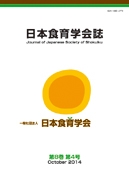
- Issue 4 Pages 171-
- Issue 3 Pages 119-
- Issue 2 Pages 71-
- Issue 1 Pages 3-
- |<
- <
- 1
- >
- >|
-
Akemi Nakanishi, Yukari Takemi2023Volume 17Issue 2 Pages 71-80
Published: April 25, 2023
Released on J-STAGE: May 02, 2023
JOURNAL FREE ACCESSThis study determined the relationship between dietary-related media literacy and habitual dietary intake among junior high school students. In total 1,456 responses from five public junior high schools were analyzed. The students were surveyed using the dietary-related media literacy questionnaire and a brief self-administered diet history questionnaire for adolescents (BDHQ15y). The respondents were grouped into three quartiles according to their scores on four subscales of dietary-related media literacy scale. These four subscales were divided into two categories, such as “critical thinking” and “autonomous judgment.” “Critical thinking” had two subscales as “influence from food advertisements and sales promotions” and “critical perception towards dietary-related media information.” “Autonomous judgment” had also two subscales as “judgment of nutritional balance” and “food label use.” The dependent variable was “food intake”; the independent variables included each subscale score, and the covariates were grade, region of residence, restrictions (by family members) on programs watched on television (TV), and TV viewing time. All trends were tested via covariance analysis.
The students with higher autonomous judgment literacy had greater habitual food intake recommended for consumption, which included vegetables, seafood, and dairy. Meanwhile, the relationship with soft drinks and sweets, the excessive consumption of which is considered as a problem, differed between boys and girls. The soft drinks and sweets were consumed less by boys with high levels of critical thinking and girls with high autonomous judgment.
View full abstractDownload PDF (1182K) -
Misaki Kaiwa, Naohiko Kinoshita, Hiromi Inaba2023Volume 17Issue 2 Pages 81-89
Published: April 25, 2023
Released on J-STAGE: May 02, 2023
JOURNAL FREE ACCESSPrevious studies reported that eating with another person renders food more delicious and increases its consumption. However, In the COVID-19 pandemic situation, eating with friends is restricted and eating and drinking via the Internet is encouraged. Few studies have focused on the deliciousness and emotions in such situations. This study conducted an experiment to examine differences in meal satisfaction and its deliciousness under three conditions, namely, solitary eating, video dining, and co-eating. The study recruited 30 college students (male : 9, female : 21). The participants ate the samples under one dietary condition per day and rated the response items. Repeated-measure analysis of variance was employed to compare the three conditions. As a result, significantly high scores for meal satisfaction and deliciousness in the following order of conditions : co-eating, video dining, and solitary eating. For all conditions, food satisfaction was found to be significantly highly influential in deliciousness. The study suggests that sharing a meal with someone, even virtually, renders food more delicious than eating alone. Online communication, such as conversations, may have exerted a social facilitation effect, which influenced the deliciousness of food. Video dining may be useful for social living during the COVID-19 pandemic and for addressing problems related to solitary eating.
View full abstractDownload PDF (478K)
-
Megumi Togawa, Yukari Takemi, Fumi Hayashi, Hiromi Kodama, Akio Kagawa2023Volume 17Issue 2 Pages 91-100
Published: April 25, 2023
Released on J-STAGE: May 02, 2023
JOURNAL FREE ACCESSThis study aimed to identify changes in children’s knowledge, attitudes and behavior due to a program that combines learning about well-balanced meals and cooking practice through a series of community-based cooking classes.
This was a non-randomized controlled trial. The comparison group was composed of participants in the cooking class held from April to September 2019, whereas the intervention group had participants of classes from October 2019-February 2020. Each session consisted of (1) a lecture on balanced meals, (2) hands-on cooking. The program of the comparison group consisted only hands-on cooking as before. Questionnaires at baseline and after intervention evaluated knowledge of well-balanced meals and attitudes and behavior related to meal preparation. The data analysis evaluated the intervention effect on the program and behavior during the program implementation period. Changes from the beginning to the end of the program were analyzed using Friedman’s test and Mann-Whitney U test.
In the intervention group, self-assessment of understanding of a well-balanced meal (p<0.001) and cooking experience with parents during the program implementation (p=0.028) improved compared to the control group.
The intervention group’s knowledge of well-balanced meals increased after the intervention (p=0.002).
The program in combination of learning about well-balanced meals and cooking classes was effective in improving their understanding about well-balanced meals among program participants.
View full abstractDownload PDF (956K)
- |<
- <
- 1
- >
- >|